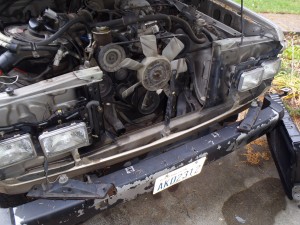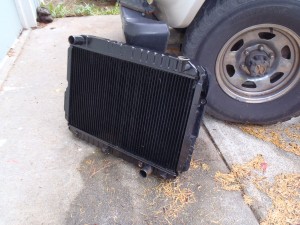 Looked out at the spouse’s wagon and saw a dreaded flood coming out from under the hood. Put off looking at it and saw some anti-freeze but nothing to indicate anything worse than a leaky hose.
Looked out at the spouse’s wagon and saw a dreaded flood coming out from under the hood. Put off looking at it and saw some anti-freeze but nothing to indicate anything worse than a leaky hose.
Decided to take a closer look and found quite a bit of coolant puddling up at the base of the radiator. Popped the cap and had to add about a gallon of coolant to top things off so now I knew I had a problem.
I will be the first to admit that Toyota got most things right when it comes to the engineering of our wagons but they did get at least two things wrong. The absolute worst is the disc brakes that require you to totally disassemble the hub to replace the rotors. But coming in a very close second is the access to the radiator of an FJ62. Who else would require you to pretty much tear down the entire front end just to remove a radiator….
Once I had things torn apart the radiator sat for a bit as I contemplated my options. This radiator wasn’t original but probably about 8 years old or more so my first thought in todays throw away world of auto parts was just to replace it with another aftermarket radiator. Fast forward to the parts counter of my friendly auto parts store and I just about choked, a replacement was more than $500 with shipping. Mail order was only slightly better and god forbid if you needed to use the warranty.
Took another look at my old radiator and decided to pressure test it before I spent a ton of money for a new one. Yep, I found the leak, or got close anyway. It wouldn’t hold any pressure and I could hear the air coming out really close to the filler neck even though it wasn’t the filler or the cap.
Then the light bulb came on. Even though I had an after market radiator, I had bought a decent one that just so happened to be made of brass and copper. Lucky for me Toyota never got into the plastic and aluminum radiators on our 60 series wagons that are so common on todays cars. But I do believe on the newer stuff, even Toyota got into the throw away mentality.
 So just why is it good to have a brass and copper radiator? They are fixable! Or at least they are most of the time and often can be rebuilt with a new core unit. Replacing the core is exactly what I had done to the radiator in my diesel. Even upped the cooling capacity by have a larger core installed between the old top and bottom tanks.
So just why is it good to have a brass and copper radiator? They are fixable! Or at least they are most of the time and often can be rebuilt with a new core unit. Replacing the core is exactly what I had done to the radiator in my diesel. Even upped the cooling capacity by have a larger core installed between the old top and bottom tanks.
But it does take some special skills to fix or rebuild a radiator properly and sometimes it takes a soak in a vat of horrible stuff to clean it up and make sure it is repairable, so off to the radiator shop it went.
The shop I used picked up my radiator on a Wednesday and I waited for a call with bad news that didn’t come. The next day they brought back my radiator, repaired, pressure tested, and painted, all for $45. Fortunately just one of the tubes for the coolant was cracked and had to be soldered up. Thank you Ken’s Radiator in Burlington, WA!
So the next time you think all the modern, latest and greatest is better, think twice because old school craftsmanship fixed my radiator for one tenth the cost of new….

